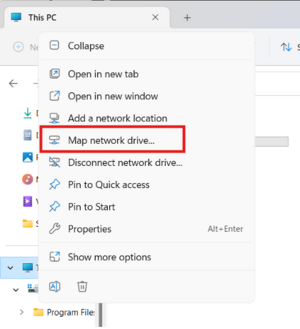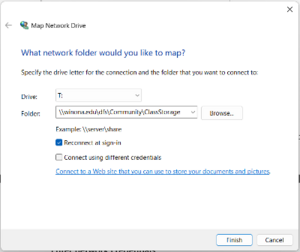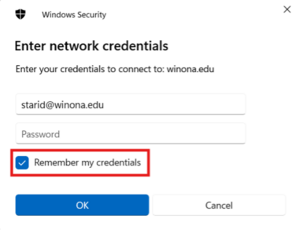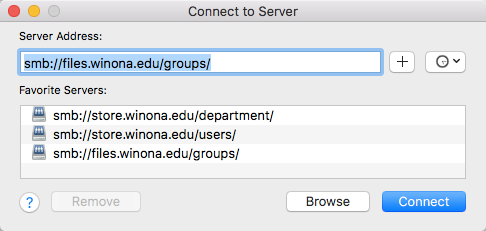Local network storage
| REVISION IN PROGRESS: This article contains useful information, but is being revised to reflect recent updates. Direct questions to TLT (tlt@winona.edu). |
All employees have access to three local network storage directories or folders on campus servers: a shared folder for departmental storage, a private folder for personal storage, and a folder that's open to the world for Web publishing. Some employees have access to a shared folder created by request for use in a specific class. Employees can access these folders using WSU devices when connected to the campus network directly or from off-campus via a VPN connection.
What's local network storage?
Local network storage refers to space on networked servers on the Winona campus administered by WSU staff. Local network storage differs from cloud storage options (e.g., OneDrive, Teams) in that WSU Information Technology Services maintains the file servers here on campus. While cloud-based file storage is more convenient and meets security standards for most files, local network storage is the more secure and the only solution for highly sensitive data. Because our system administrators maintain local network storage, it's also a good way to provide services like Web and class storage that require oversight and customization.
What can be saved to local network storage?
- Local network storage is intended for university-related use only. Do not store your personal files (e.g., family pictures, vacation videos) to any network storage folder. Please consult the personal versus work-related laptop and tablet use article for more information about handling personal files.
- Employees, with the exception of your web or "Course1" folder, local network storage is the only place suitable for saving highly-sensitive, private university data. Please consult our data sensitivity and file storage article for more information about handling private data.
- Never store sensitive or private information in your Course1 folder. It is open to the world.
Local network storage folders
Personal
Every employee has 4 GB of personal network storage on a local campus network server. PC users know this as their R drive (Fig 1). Mac users connect to smb://store.winona.edu/users/[your StarID] (Fig 2). You can use your personal drive to store any work-related file, but it is highly recommended for private university data (e.g., student grades, employee performance reports). You are the only person that can access this storage area.
Department
Depending on the department to which they belong, employees have shared access to one or more network folders, along with other members of the department (i.e., files are not private). PC users know this as their S drive (Fig 1). Mac users connect to smb://store.winona.edu/department (Fig 2). You can use your department drive to store any work-related file, but it is designed to provide access to common files that must be shared within the department. It can also store private university data (e.g., student grades, employee performance reports). However, keep in mind that others in the department have access to these files.
Web
All employees have access to their own folder on a campus Web server. Some PC users may refer to this as their W drive (Fig. 1). Mac users connect to smb://webstore.winona.edu/webstore/course1/[your StarID] (Fig. 2). Every file you place in this drive is available to the world through the Web. You can connect to this drive and save files to it just like you would any other network drive. Because this is a specialized drive used to post Web content, there are a few more steps to using it. Please refer to the articles below for more detailed information:
Class
An instructor can request that a network storage folder be created for the duration of a course that is only accessible to the instructor and students of that course. Each student has a personal subfolder and a shared folder that everyone can use. These files are also accessible via web browser by the account owner.
Access from on campus
PC users
All your local network storage folders should appear in File Explorer automatically if you connect to the campus network with a wire (e.g. when using a desktop) or to WAZOO when using WiFi.
- Select the icon on your taskbar at the bottom of your screen to open File Explorer. If you don't have this pinned to your taskbar, search your computer for "file explorer." Scroll down to the bottom of the list of locations on the left. Your local network storage folders should be listed under the Network Locations or This PC heading (Fig. 3). You may need to expand that list to see them.
- Open the folder you wish to access.
- If you do not see your folders listed, select the Click to Map Network drive tile on the Start Menu (Fig 4). A black command window will open on your screen (Fig. 5). Wait until the window closes. It may take up to a minute. Check File Explorer again. Contact the Technical Support Center (TechSupport@winona.edu, 507-457-5240, Somsen Hall 207) if your folders are still missing.
New PC users (2024)
NOTE: This applies to Intune PC users. If you are unable to click to map network drives follow the below steps.
- Open File Explorer and select “This PC” on the left menu bar.
- Right click on “This PC”
- Then select “Map network drive…”
- A new window will appear. The letter “Z” will automatically appear in the “Drive” dropdown menu. From the dropdown menu select “T.”
- In the box labeled “Folder” copy the following path: \\winona.edu\dfs\Community\ClassStorage
- Then select finish.
- A new window will appear. Enter your StarID@winona.edu and your StarID password.
- Select the “Remember my credentials” box and then select “ok.”
- Your T drive should load.
- This drive may disconnect, we suggest creating a notepad file on your desktop with the \\winona.edu\dfs\Community\ClassStorage in it.
- You can also add a shortcut to your desktop for the drive by:
- Once your T drive is loaded in your File Explorer you can create a shortcut.
- Select your T drive and drag and drop the file onto your desktop.
Mac users
- In Finder, select Connect to Server from the Go menu. You can also press and hold the <Command> key, then tap the <K> key to bring up the Connect to Server window (Fig 6).
- Enter one of the following server locations: smb://store.winona.edu/users/ (personal), smb://store.winona.edu/department/ (department), or smb://files.winona.edu/classes (class). Select the + icon to save the server location as a favorite.
- Select Connect on the You are attempting to connect window (Fig 7).
- Select Connect As Registered User. Enter your StarID username and password and select the Remember this password in my keychain checkbox. Select Connect (Fig 8).
- The server location will appear as an icon on your desktop, indicating your connection.
Access from off campus
Establish a VPN connection and then follow the instructions for on campus access.
More wiki articles
External links
- Minnesota State Operating Instruction 5.23.2.1 Data Security Classification
- WSU Information Security page
- WSU IT regulations, standards, and procedures.
Except where otherwise noted, text is available under the Creative Commons Attribution-NonCommercial-ShareAlike 4.0 International License.











